
Finger length: long fingers vs. short fingers + the implications!
![Abnormal finger lengths: long fingers [dolichodactyly] vs. short fingers [brachydactyly].](http://www.handresearch.com/diagnostics/finger-length/abnormal-finger-lengths-long-fingers-short.jpg)
Many people wonder about the significance of their finger length, but what can your finger length really reveal?
Basically, your finger length represents a measure for various personal features that you have, such as: body height, sexe, ethnicity (these 4 factors are largely determined by your genes & chromosomes) and your personality!
10 Sub-sections are presented below, each section covers a different aspect involving the meaning of finger lengths. The continuation of this page presents a quick summary for each section.
How to understand finger length abnormalities properly + how to assess your finger length correctly?

![]() FINGER LENGTH INDEX (10 sub-sections):
FINGER LENGTH INDEX (10 sub-sections):
INTRO: Finger length & the meaning of long- vs short fingers!
• Finger length: HOW TO ASSESS your finger length?
• Finger length RE-DEFINED: evolution, genes, hormones
• Finger Length AROUND THE WORLD
• Finger Length: MALES VS. FEMALES
• Finger Length: MASCULINITY & FEMININITY
• Finger Length & PSYCHOLOGY
• Finger Length ABNORMALITIES (MPAs)
• Extraordinary long fingers: dolichodactyly
• Finger Length proportions & HAND SHAPES
• HAND SIGN TUTOR: Finger Length - quick summary
Fingers have many fascinating aspects: there is a lot to tell. In order to decode specific meaning for finger length in an individual, a precise measurement of the 3rd (middle) finger length is required in order to put it in the perspective of various hand features - such as: the dimensions of the palm, hand shape, hand lines & the dermatoglyphics. Guidelines are presented serving to assess your finger length very precisely!
But first, let's take a quick look back in time in order to see how the knowledge about finger lengths has evolved:
- The significance of finger lenghts has been recognized in the fields of palmistry since it's early days, but in the fields of academic science it became recognized much later.
- During the 2nd half of the 20th century the significance of extraordinay finger lengths (abnormalities) became recognized to represent a 'Minor Physical Anomaly' [MPA]. In this perspective finger length suddenly became a topic of consideration in the fields of health, psychiatry & psychology.
- In the 1st decade of the 21th century the so-called 2D:4D digit ratio suddenly became a regular item in popular & scientific media. However, the length of the middle finger (3rd digit = 3D) actually represents a much more revealing measure.
Your finger length is a measure for: body height, sexe, ethnicity & your personality. Before jumping into details, let's take a look first at how we can assess finger length.

I - Finger length: HOW TO ASSESS finger length?
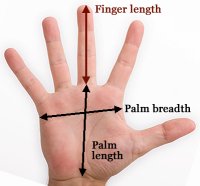 Proper assessment of finger length requires a measurement of the length of the third finger - which is measured as the distance between the tip of the third finger and the proximal finger crease seperating the third finger from the palm (see picture).
Proper assessment of finger length requires a measurement of the length of the third finger - which is measured as the distance between the tip of the third finger and the proximal finger crease seperating the third finger from the palm (see picture).
However, finger length can only become meaningful in the perspective of other hand dimensions! Therefore measurements of palm width (where the metacarpals end) and palm length (= distance between finger crease and wrist crease) are also required, in order to attribute any specific meaning to finger length in an individual. ...more
II - Finger length RE-DEFINED:
evolution, genes, hormones
For more than a century finger length (proportion) has been known to represent a manifestation of genetics & hormones combined. Unfortunately, the assessment of finger length proportion has not been defined very well. So far nearly all sources have defined finger length proporation relative to a single aspect of the palm: some sources use palm length, other sources use palm breadth (= hand width measured at the metacarpals). But interestingly, the argument for using only palm length or palm breadth is missing: it appears that choices in the past were made on just arbitrary preferences. A new approach is presented to re-define finger length proportion: finger length relative to the average of (both) palm length and palm width together, the so-called 'finger length index'! ...more
III - Finger length AROUND THE WORLD
Finger length varies significantly among populations around the world. Ergonomic data reported in various international studies suggest that finger length relative to palm width (or palm length) may vary between the continents even up to 20% (or 12%) - but within each continent the variation among populations appears to be much smaller! ...more
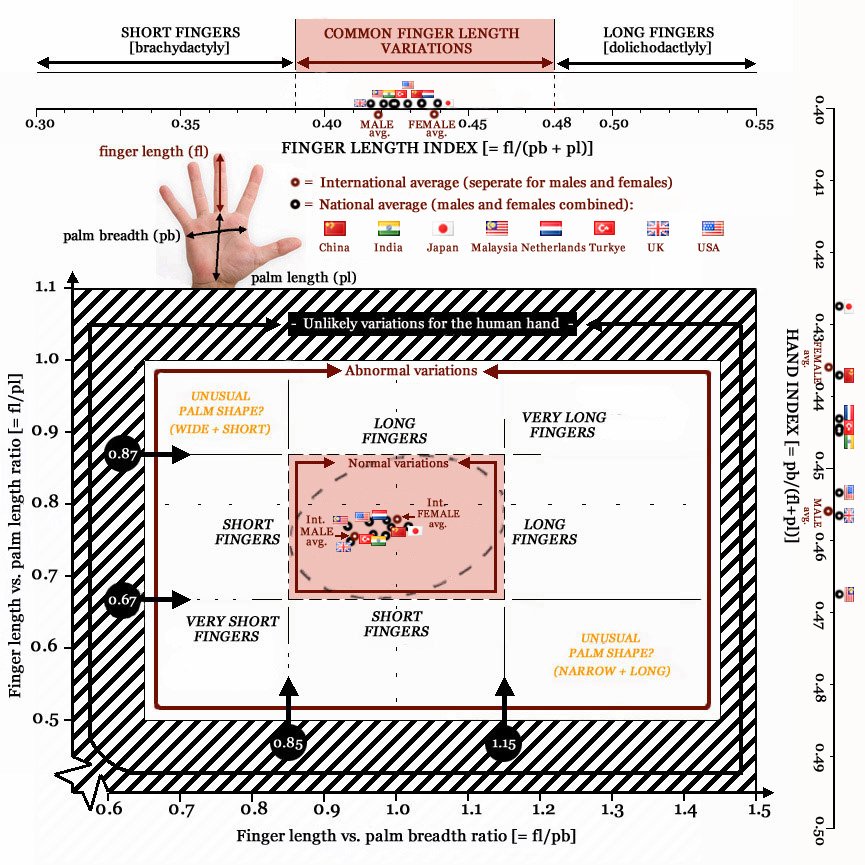
IV - Finger length: MALES vs. FEMALES
International studies show that finger length varies with sexe: females tend to have slightly longer fingers (compared to males) in the perspective of palm breadth, palm length & hand length. However, one should also be aware that men tend to have longer finger length in the perspective of body height - because men tend to have relatively longer limbs.
The most stricking difference between men and women in this perspective is that men typically tend to have shorter finger length compared to palm breadth (confirmed in a very large majority of international studies), while women tend to have slightly longer fingers compared to palm width (confirmed in a majority of international studies). The average size of this effect in international populations appears to be close to 2.5%, which implicates that in the hands of women finger length relative to palm width tends to be about 2mm longer (relatively compared to the hands of men).
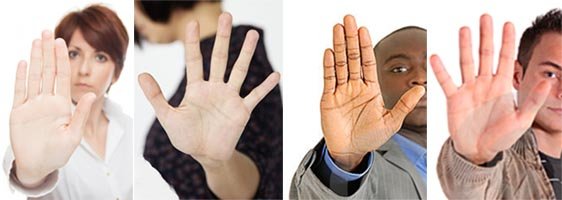
This phenomenon can be understood in the perspective of another phenomenon involving the 2D:4D digit ratio: men typically have ring finger (4D) > pointer finger (2), while in women the length of both fingers tends to be equal. ...more
NOTE: 2D:4D > 1 is a.k.a. the 'human digital formula'
V - Finger length: MASCULINITY & FEMININITY
via finger length & hand shape ratios?
During the 1st decade of the 21th century 2D:4D Digit ratio became known as a popular scientific measure for masculinity (associated with low digit ratios) and feminity (associated with high digit ratios).
Small 2D:4D digit ratios (0.95 or smaller) produced when the ring finger is longer than the index finger are an indication of greater exposure to prenatal testosterone and might therefore be considered a measure of masculinity.
Similarly, larger ratios (0.98 or higher), where the index finger is almost equal to or longer than the ring finger, result from greater exposure to oestrogen and therefore might be thought of as a measure of femininity.
However, hand shape and finger length ratios provide a few other clues that relate to masculinity/femininity.
A 3-step hand-assessment is presented (based on 2D:4D digit ratio and three hand shape ratios) that provides a guide to recognize masculinity and femininity from the hand of an individual. ...more
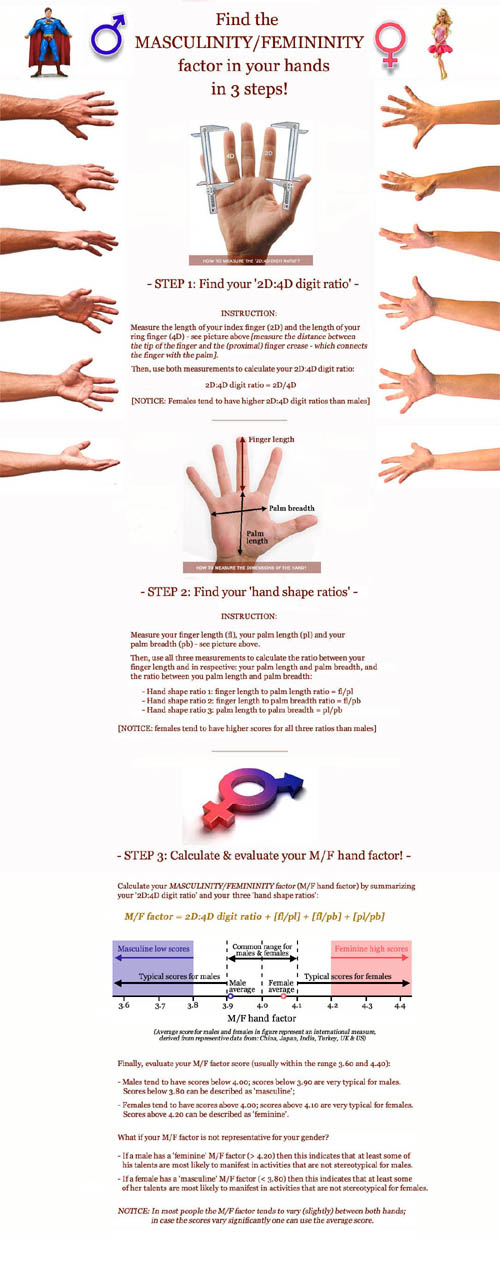
VI - Finger length & PSYCHOLOGY
What can long fingers and short fingers indicate in the perspective of the so-called Five Factor Model (a.k.a. the 'Big Five' personality dimensions)? Can finger length in individuals represent anything specific in the perspective of behavior and psychology?
Authors have suggested that short fingers meaning may indicate a "quick mind", a "hasty nature", and/or an "impetuous disposition"; 'long fingers' may indicate "slow going and slow talking", and/or "going into the details of things" (quoted from 'Encyclopaedic Dictionary Of Palmistry'). Is there any solid ground for the specific assumptions made in the fields of palmistry, palm reading & hand analysis regarding finger length?
Additionally, one can also explore other specific finger length variations such as: finger shapes, the high- and low 2d:4d digit ratio, and individual short- or long finger lengths such as a long- and short thumb, and long- and short pinky finger length meaning.
So far there was hardly any research available, but brand new materials (2012) point out that finger length has a link with personality! ...more
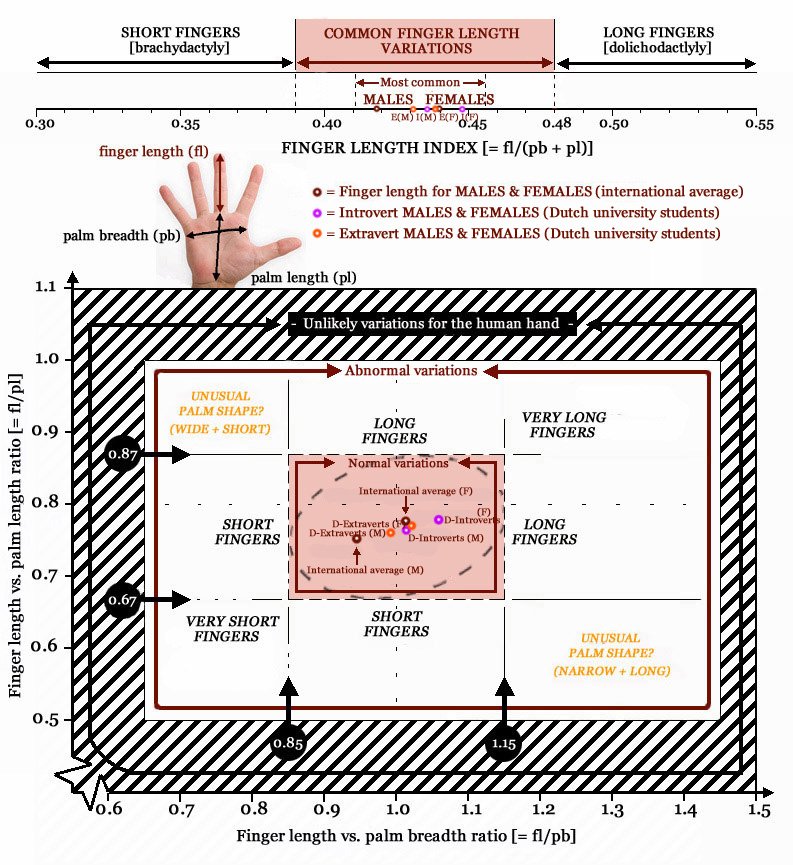
![Extraordinary long fingers [dolichodactyly].](http://www.handresearch.com/diagnostics/finger-length/abnormal-long-fingers-dolichodactyly.jpg)
VII - Finger length ABNORMALITIES (MPAs)
The significance of finger length can best be understood in the perspective of the extreme variations:
- Abnormal long fingers [olichodactyly] is a common feature in various medical/genetic conditions; Marfan syndrome & Loeys-Dietz syndrome are most common examples.
- Abnormal short fingers [brachydactyly] is a common features in various genetic conditions; Down syndrome & Rubinstein-Taybi syndrome are the most common examples.
However, sometimes these finger length abnormalities are also seen in people who do not have any of the conditions mentioned. ...more
VIII - Extraordinary long fingers: dolichodactyly
Long fingers are usually of no concern, as normal finger length is known to vary within a wide range that depends on various factors (including e.g. sexe & ethnicity).
However, the condition of extraordinary long fingers - a.k.a. 'dolichodactyly' - may be recognized to represent an important feature of not only genetic syndromes, it also may represent a clue in metabolic diseases, in-utero exposure to teratogenic substances, as well as other miscellaneous conditions. ...more
![Extraordinary short fingers [brachydactyly].](http://www.handresearch.com/diagnostics/finger-length/abnormal-short-fingers-brachydactyly.jpg)
XI - Finger Length proportions & HAND SHAPES
In the field of hand reading is finger length considered as an important point of reference for hand shape.The work of psychologist Charlotte Wolff became a significant milestone, describing how hand shape (hand form) relates to the mental deficiencies, learning problems & psychiatric disorders.
In modern times the so-called 'elemental hand shapes' became a popular (philosophical) model for studying finger length + palm shape in the perspective of basic character- and personality traits. Not only your fingerprints are unique: even hand shape became in time a tool for personal identification. ...more
X - HAND SIGN TUTOR: finger length
The Hand Sign Tutor present 7 options for finger length assessment. ...more
Next major section:
• The Fingernail Encyclopedia & Nail Tutor!
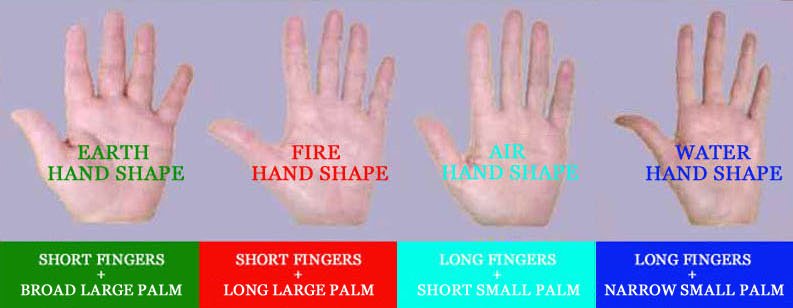
Finger length as a point of reference in the elemental hand shapes
earth hand shape - fire hand shape - air hand shape - water hand shape